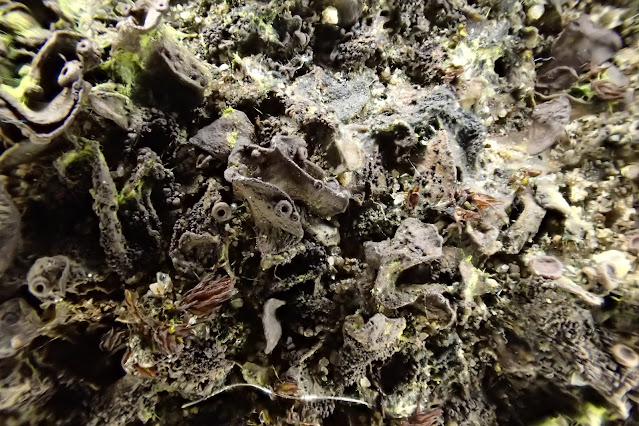Reflections on - visiting a site too early, some new flowers for 2024, almost the lowest part of the Ribble and my hectad (c 135 m) and sense of place - and YES it is Xanthoria calcilola at the stile.
I will deal with lichens first.
(Read about the wildflowers here)
I revisited the stile that I remember so well from 2020. Here I had found what I thought was my first Xanthoria calcicole. Is howed it on our Zoom sessions and other people said "no". But I looked at it now .. having seen lots more Xanthoria calcicola - and it definitely is Xanthoria calcicola. There are no fruiting bodies, the middle of the thallus is warted, and the edges of the thallus are a brighter lemonier yellow
 |
| As I picked bits of this thallus out, the underpart was reddish which is why I make the Lecanora gangaleoides |
Nearby was a limestone boulder
 |
| A nearby limestone boulder close to the river had a Collema growing on it. |
 |
| Collema |
 |
| And some sort of Caloplaca |
 |
| ANd a Lecanora - maybe Lecanora dispersa |
This monad SD8163 includes
most of Settle (except Upper Settle.)
most of Giggleswick (except the church, The Mains, all three - four schools, Stackhouse Lane and Four Lane Ends)
The Ribble from Queens Rock down to Penny Bridge and the two Fields below that.
Todays walk was the Ribble in the second field below Penny Bridge. I had had a wonderful time there in Lockdown at the End of June 2020. I explored it this evening to see what was there and out a month earlier:
Answer: not as much as in late June/July. So negative results are as good aa positive - and if you are only going to walk this path once, then I say come back a month later. and don't go just after the river levels have been high.
However I cna say - the Rest Harrow is still there (but not flowering yet) , The Dames violet (Hesperis matronalis) was there in the form of three shoots mostly in but but there were two flowers out - It may be a garden escape anyway), There were lots of Ox eye daisies in bud.
The Money flower - Mimulus guttatus had its golden yellow flowers nodding, but was draped in mosses and other river debris left from high river levels two days previously.
Three was one plant of Pyrenean Scurvey grass.
The field is a flat field leading to the barn, and is well grazed and will be well fertilised - or at least manured. The river bank shows slippage. Here there ought to be good species - maybe I should come back in August. The river cuts into the alluvial material (rounded boulders) there is an area of (very old) concrete which might have been put here long ago to stop river erosion.
On the slippage area I found more Geranium dissectum (I had seen this in Giggleswick Station) and I found Trifolium dubium - Lesser Trefoil.. but this is leading into the next monad SD8162
I revisited the stile that I remember so well from 2020. Here I had found what I thought was my first Xanthoria calcicole. Is howed it on our Zoom sessions and other people said "no". But I looked at it now .. having seen lots more Xanthoria calcicola - and it definitely is Xanthori calcicola. There are no fruiting bodies, the middle of the thallus is wardted, and the edges of the thallus are a brighter
The
It













No comments:
Post a Comment